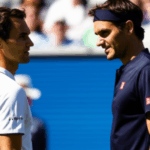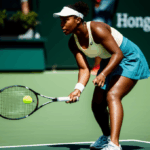The French Open, held annually at Roland Garros in Paris, is the most grueling Grand Slam for men’s tennis. The slow red clay tests endurance, strategy, and mental fortitude like no other surface. It’s a battle of attrition, a chess match played with heavy topspin and relentless defense. This article ranks the seven men who have dominated the terre battue with the highest win rates in the tournament’s history, showcasing their unparalleled achievements on this challenging surface.
Why Win Rate Matters at the French Open
Win rate, in this context, is a straightforward calculation: a player’s total wins at the French Open divided by their total matches played. It’s a powerful indicator of sustained excellence. While winning a single title is commendable, maintaining a high win rate over many years speaks to a player’s mastery of clay-court tennis and their ability to consistently perform at the highest level under immense pressure. This metric favors players who not only win often but also avoid early-round upsets, demonstrating a remarkable level of consistency and dominance.
The Ranking Criteria
The list that follows is based on the following criteria:
- Minimum Matches Played: To ensure statistical significance, a minimum of 30 matches played at the French Open is required. This eliminates players with only a few appearances, focusing on those with substantial tournament history.
- Win Rate Calculation: The win rate is calculated as (Total Wins / Total Matches Played) * 100.
- Data Sources: Information is compiled from official tournament records, reputable tennis websites, and news archives to ensure accuracy.
Let’s delve into the rankings of the seven men who have etched their names in French Open history with their exceptional win rates.
1. Rafael Nadal: The Undisputed King of Clay (96.55%)
- Years Played: 2005-2024
- Matches Played: 116
- Wins: 112
- Losses: 4
- Titles: 14
Rafael Nadal’s reign at Roland Garros is unparalleled. With a staggering 14 titles, he has dominated the tournament in a way never seen before in men’s tennis. Nadal’s win rate of 96.55% is not just the highest at the French Open but also the highest of any player at any Grand Slam in history. His dominance is so complete that many consider him the greatest clay-court player of all time.
Key Strengths:
- Aggressive Topspin: Nadal’s heavy topspin forehand is particularly devastating on clay, making the ball bounce high and challenging opponents.
- Court Coverage: His speed and agility allow him to cover every inch of the court, retrieving shots that most players wouldn’t reach.
- Mental Fortitude: Nadal’s unwavering focus and determination make him incredibly tough to beat, especially in pressure situations.
- Adaptability: Over the years, Nadal has adapted his game, improving his serve and net play to complement his baseline prowess.
Nadal’s record at the French Open is filled with incredible statistics:
- He won the tournament on his debut in 2005 at just 19 years old.
- He has won the title without dropping a set a record four times (2008, 2010, 2017, 2020).
- He holds the record for the most consecutive titles in the Open Era, with five from 2010 to 2014.
- He has only lost four matches at Roland Garros, to Robin Soderling (2009), Novak Djokovic (2015, 2021), and Alexander Zverev (2024).
- His 14-0 record in French Open finals is unmatched.
Michael Chang, a former French Open champion, stated that Nadal’s dominance on clay is “unfathomable” and that it is unlikely anyone will match his achievements in our lifetime. Nadal’s legacy at Roland Garros is secure, and his impact on the sport will be felt for generations.
2. Björn Borg: The Ice Man on Clay (89.29%)
- Years Played: 1973-1981, 1991-1993
- Matches Played: 56
- Wins: 50
- Losses: 6
- Titles: 6
Björn Borg, the “Ice Man” from Sweden, dominated the French Open in the late 1970s and early 1980s. His win rate of 89.29% is the second-highest in tournament history, and he won six titles between 1974 and 1981. Borg’s calm demeanor, combined with his exceptional athleticism and baseline game, made him a formidable opponent on clay.
Key Strengths:
- Baseline Consistency: Borg’s ability to consistently hit deep, accurate groundstrokes wore down opponents.
- Two-Handed Backhand: His powerful two-handed backhand was a major weapon, allowing him to control rallies and dictate play.
- Mental Toughness: Borg was known for his incredible mental strength, rarely showing emotion on court.
- Physical Fitness: His exceptional fitness allowed him to endure long, grueling matches on clay.
Borg’s achievements at the French Open include:
- Four consecutive titles from 1978 to 1981.
- He won the title without dropping a set in 1978.
- He reached the final in 1974 at just 18 years old.
Despite retiring at the peak of his career at the age of 26, Borg’s impact on the French Open remains significant. His six titles and high win rate solidify his place as one of the greatest clay-court players of all time.
3. Novak Djokovic: The Modern Master (85.19%)
- Years Played: 2005-2025
- Matches Played: 108
- Wins: 92
- Losses: 16
- Titles: 3
Novak Djokovic, one of the “Big Three,” has consistently challenged Nadal’s dominance at Roland Garros. With a win rate of 85.19%, Djokovic has proven his ability to excel on clay, winning three titles (2016, 2021, 2023) and reaching the final on six occasions. His all-around game, combined with his mental toughness and strategic brilliance, makes him a threat to anyone on the surface.
Key Strengths:
- Return of Serve: Djokovic’s exceptional return of serve puts pressure on opponents from the first ball.
- Flexible Game: Djokovic can adapt his game to any opponent or surface, playing aggressively or defensively as needed.
- Mental Resilience: He is known for his mental strength, often raising his level in crucial moments.
- Court Sense: His anticipation and court awareness allow him to read his opponent’s game and position himself effectively.
Djokovic’s accomplishments at the French Open include:
- He is one of the few players to have defeated Nadal at Roland Garros, doing so twice (2015, 2021).
- He completed a Career Grand Slam by winning the French Open in 2016.
- He is the oldest champion of the Open Era, winning the 2023 French Open at 36 years old.
Djokovic’s pursuit of Grand Slam titles has often led him to Roland Garros, where he has consistently performed at a high level. His three titles and impressive win rate underscore his status as one of the greatest players in the Open Era.
4. Ivan Lendl: The Grinder (81.82%)
- Years Played: 1978-1994
- Matches Played: 77
- Wins: 63
- Losses: 14
- Titles: 3
Ivan Lendl, known for his intense training regime and methodical approach to the game, was a force to be reckoned with at the French Open. His win rate of 81.82% is a testament to his consistency and determination. Lendl won three titles (1984, 1986, 1987) and reached the final on two other occasions.
Key Strengths:
- Power and Precision: Lendl’s powerful groundstrokes, combined with his precise shot placement, made him a difficult opponent.
- Topspin Forehand: His heavy topspin forehand allowed him to control the tempo of rallies.
- Physical Conditioning: Lendl’s dedication to physical fitness gave him an edge in long matches.
- Strategic Play: He was known for his tactical acumen, carefully constructing points and exploiting his opponent’s weaknesses.
Lendl’s notable achievements at the French Open include:
- Three titles in four years (1984, 1986, 1987).
- He reached the final in 1981 and 1985.
- His consistent performance helped him become the world No. 1 player for many years.
Lendl’s success at Roland Garros is a testament to his hard work and dedication. His three titles and high win rate cement his place as one of the top clay-court players of his era.
5. Mats Wilander: The Tactical Master (76.92%)
- Years Played: 1981-1996
- Matches Played: 78
- Wins: 60
- Losses: 18
- Titles: 3
Mats Wilander, another Swede known for his tactical brilliance and mental toughness, also left his mark on the French Open. With a win rate of 76.92%, Wilander won three titles (1982, 1985, 1988) and was known for his ability to outthink and outmaneuver his opponents on the slow clay surface.
Key Strengths:
- Tactical Acumen: Wilander’s ability to analyze his opponent’s game and adjust his strategy accordingly was a major asset.
- Consistent Groundstrokes: His reliable groundstrokes and ability to keep the ball in play frustrated many opponents.
- Mental Strength: Wilander was known for his calm demeanor and ability to perform under pressure.
- Adaptability: He could adjust his game to suit different opponents and court conditions.
Wilander’s achievements at the French Open include:
- He won his first Grand Slam title at the French Open in 1982 at just 17 years old.
- He won the title in 1985 and 1988, completing a Career Grand Slam.
- He was known for his sportsmanship and fair play.
Wilander’s three titles and impressive win rate at Roland Garros underscore his reputation as one of the smartest and most effective clay-court players of his time.
6. Roger Federer: The Elegant Exception (75.86%)
- Years Played: 1999-2015, 2019
- Matches Played: 87
- Wins: 66
- Losses: 21
- Titles: 1
Roger Federer, celebrated for his elegance and all-court game, found the most success on faster surfaces, but he still managed to secure a respectable win rate of 75.86% at the French Open. Despite clay not being his preferred surface, he reached the final five times, winning the title in 2009. Federer’s adaptability and sheer talent allowed him to contend with the best on clay, even in an era dominated by Nadal.
Key Strengths:
- All-Court Game: Federer’s ability to play aggressively from the baseline and at the net made him a versatile opponent.
- Serve and Forehand: His powerful serve and precise forehand were major weapons on any surface.
- Adaptability: Federer’s ability to adjust his game to different surfaces and opponents was a key to his success.
- Elegant Style: His graceful movement and shot-making ability made him a joy to watch.
Federer’s accomplishments at the French Open include:
- He won the title in 2009, completing a Career Grand Slam.
- He reached the final in 2006, 2007, 2008, and 2011, losing to Nadal each time.
- His victory in 2009 was particularly significant as it came after Nadal’s shock defeat to Robin Soderling.
While clay may not have been his favorite surface, Federer’s success at Roland Garros demonstrates his incredible talent and adaptability. His single title and high win rate are a testament to his status as one of the greatest players of all time.
7. Guillermo Vilas: The South American Pioneer (75.00%)
- Years Played: 1972-1992
- Matches Played: 68
- Wins: 51
- Losses: 17
- Titles: 1
Guillermo Vilas, an Argentinian left-hander, was one of the pioneers of the modern clay-court game. With a win rate of 75.00% at the French Open, Vilas won the title in 1977 and was known for his exceptional endurance and topspin-heavy game.
Key Strengths:
- Topspin Groundstrokes: Vilas was one of the first players to use heavy topspin on his groundstrokes, making the ball bounce high and challenging opponents.
- Endurance: His incredible stamina allowed him to outlast opponents in long, grueling matches.
- Left-Handed Advantage: His left-handed serve and groundstrokes gave him a unique angle on the court.
- Passionate Play: Vilas was known for his emotional and energetic style of play.
Vilas’s achievements at the French Open include:
- He won the title in 1977, defeating Brian Gottfried in the final.
- He reached the final in 1975 and 1978.
- He was one of the most popular players of his era.
Vilas’s success at Roland Garros helped pave the way for future South American players on the professional tour. His title and high win rate underscore his importance in the history of clay-court tennis.
Conclusion
The French Open demands a unique blend of skill, endurance, and mental toughness. The players listed above have not only mastered the art of clay-court tennis but have also consistently performed at the highest level on this challenging surface. From Nadal’s unparalleled dominance to Federer’s elegant adaptability, each player has left an indelible mark on the tournament’s history. Their impressive win rates serve as a testament to their greatness and solidify their place among the legends of the game. As new generations of players emerge, the standards set by these seven men will continue to inspire and challenge them to reach new heights at Roland Garros.








No Comment! Be the first one.